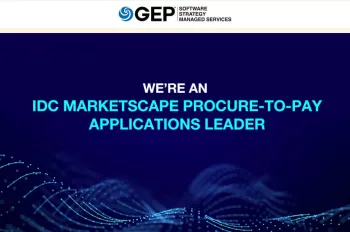Introduction
As enterprises search for innovative ways to reduce overheads and streamline during an economic recession, Management looks to its procurement leaders to find innovative ways to reduce costs. Overlooked by procurement at times, Purchasing Cards (P-Cards) can be an expert's tool to streamline purchasing processes for low-cost items.
The most common purchase methods include purchase orders (POs), checks, recurring payments and petty cash to pay suppliers. These methods offer legal terms and conditions to cover any liability and may provide robust records for payment, delivery and execution of services. However, these methods are also expensive and may not be appropriate for certain purchases.
P-Cards are not a new concept, but can reduce costs for enterprises looking to streamline low-dollar and/or high volume transactions. Based on a 2010 study1, the average, monthly P-Card spend per organization surveyed was $1.8 million, with an average transaction value of $315. Between the years of 2007 and 2009, North America's P-Card spend grew from $137 billion to $161 billion. Annual purchasing card spending is expected to increase to $213 billion by 2012, and $255 billion by 2014, considering a growth rate of 12 per cent for the next five years after 2010.
P-Card Program
In order to take advantage of P-Cards, a company must first enter into a P-Card program with a provider of such cards. This program must work in tandem with the company's pre-existing processes. It will require a dedicated leadership team that embraces this change and facilitates its implementation throughout the firm. A P-Card program is only successful as long as those using it are following policy guidelines and providing all the necessary information to the P-Card management team.
A clear understanding and communication of the P-Card processes and policies will ensure full compliance across the business and help maximize the benefits of the program.
Types of Cards
There are several cards available to companies that can assist in tracking and ensuring cardholders follow the policies set forth by the business.
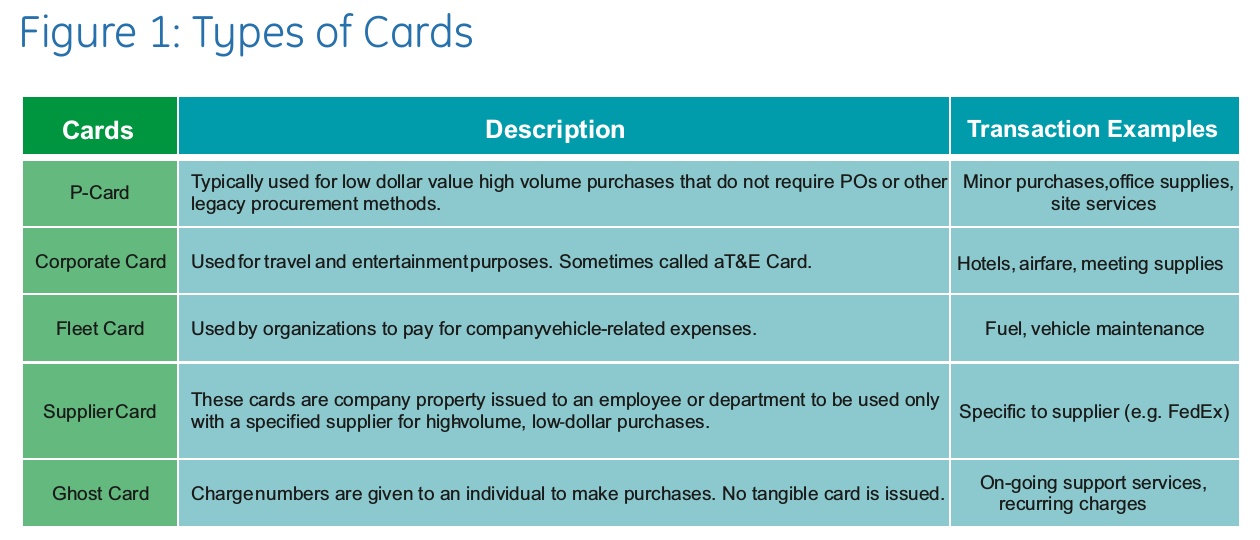
P-Card Process
P-Card processes begin with a cardholder. Cardholders are issued cards from the program office to pay for goods or services. While making a transaction, the merchant accepts the P-Card and processes the transaction. Once the transactions for a particular month are completed, a monthly statement is issued to the cardholder or the company headquarters by the P-Card-issuing bank.
The card-issuer will traditionally provide a single bill to the company, to be paid on a monthly basis. Companies do not usually carry a balance on these cards, but pay the card-issuer once per month for the total amount owed. The liability for paying the card-issuer resides with the company, not the cardholder. The cardholder's responsibility is to follow company policies and procedures regarding card usage. Proper documentation should be obtained for the purchases in the billing summary and filed with the P-Card department.
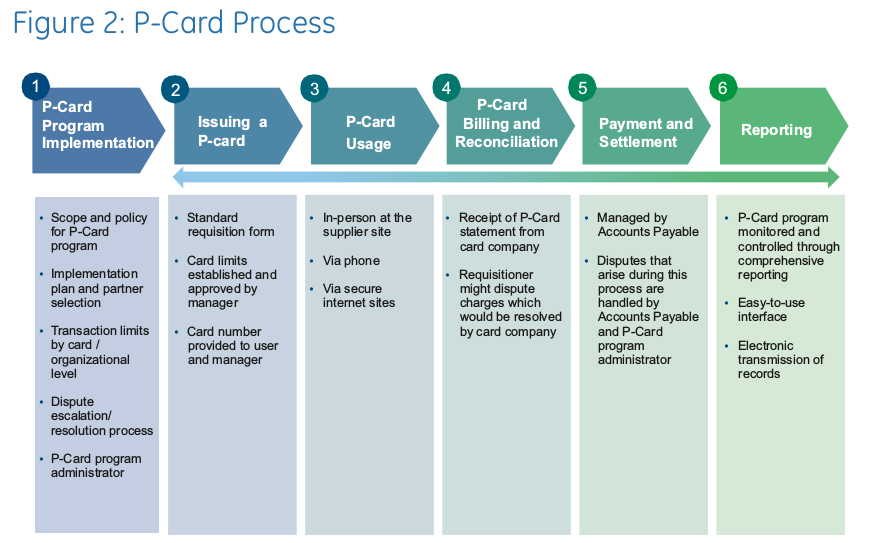
P-Card Program Policies
P-Card program policies are developed by the company's accounts payable and procurement departments and enforced by the P-Card Program Office (set up at the start of the P-Card program). Policies are necessary to prevent fraud and misuse and provide a platform for governance. The P-Card team is required to train P-Card holders regarding the policies, and the consequences of not following them appropriately. The diagram below shows policies that many companies adopt, as well as the typical allowable and prohibited charges associated with a P-Card program.
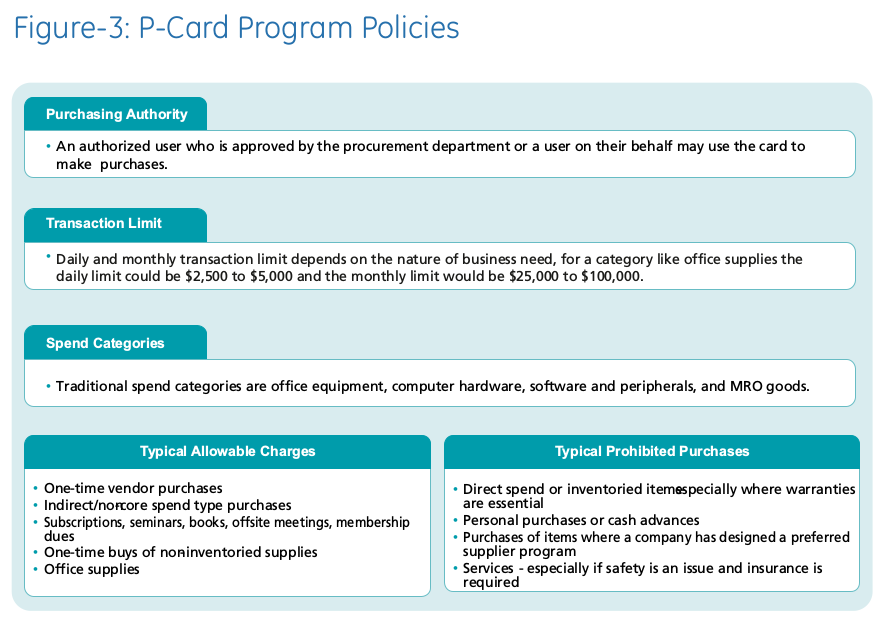
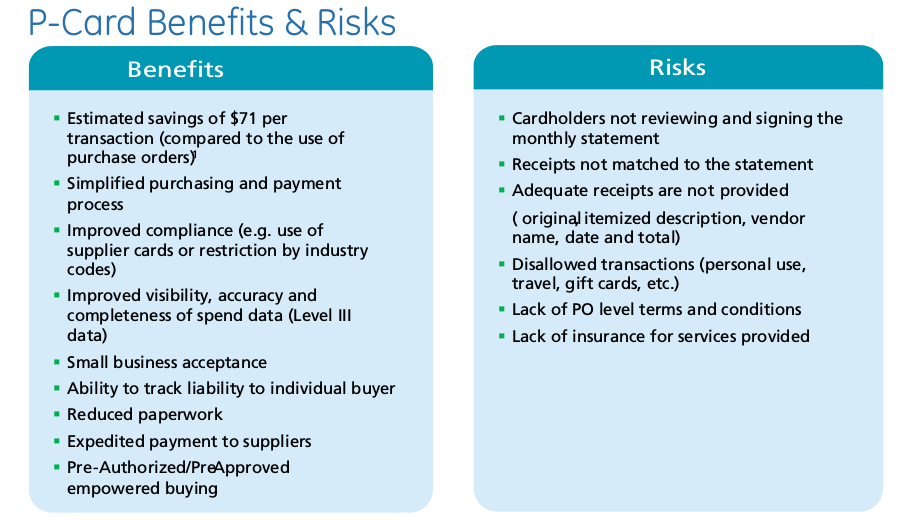
Auditing
Taking the appropriate auditing steps will also help mitigate some of the risks inherent in P-Card programs. Audits are typically performed on a monthly basis by an internal auditor, who is part of the P-Card program team. It is also advisable to have a third-party company conduct random audits to safeguard against any external audits that can occur at any point in time.
These auditors should be looking for three main requirements:
- Proper validation through signatures, both from cardholder and their manager
- Submission of appropriate support documentation
- Policy compliance, leaving no room for prohibited transactions
Independent checks ensure fair utility and application, the lack of which may expose the firm to federal audits and possible Sarbanes-Oxley violations.
Technologies
Many companies use paper-based transaction summaries and receipts. Depending on the size of a P-Card program, this could be an added cost in terms of materials and time. There are technologies that can help reduce this cost and can work in tandem with legacy systems. Some of these technologies include e-faxing for those businesses that are spread-out across the country, or globe. E-faxing solves the paper-based auditing problem by having all faxed information digitized and sent to a centralized email box. This can then be reviewed by the internal auditing team.
Card issuers also provide software solutions for tracking P-Card spend that can assist with billing reconciliation, which can then be exported and merged with a company's payables system and spend analysis tools. These improvements help streamline a P-Card process, providing flexibility to either keep the auditing and archiving process on-shore, or transferring it off-shore for further potential savings. By utilizing a company that specializes in P-Card management, a company can drastically cut down on overhead costs related to the program.
P-Card Program Responsibilities
There are several factors to consider during resource planning for a P-Card program. Firms need to ensure they allocate enough resources to cover critical components of the program. Responsibilities that are considered important are listed below:
- Administration of P-Cards (including setup and cancellation)
- Help desk to answer cardholder questions
- Month-end reconciliation reviews
- Maintaining and updating P-Card Training
- P-Card systems and archive management
- Policy maintenance and enhancements
- Interface with P-Card providers (e.g., Visa) and issuing banks (e.g., Citibank)
- Team and process management
- Governance
An estimate indicates that one full-time equivalent (FTE) is needed within a P-Card program for every 500 cardholders.
The Big Question – In-source or Outsource?
In-sourcing or outsourcing a P-Card program is a critical question. A company may want to maintain greater control over the program and keep it in-house. Most P-Card programs start in this manner. However, some organizations do not view the P-Card program as a critical function that should tie up valuable internal resources.
There are many full-service procurement outsourcing firms that specialize in these types of services. Some of the benefits of outsourcing P-Card programs to such providers include reduced personnel costs, fewer implementation pains and better use of technology solutions. Using an experienced firm helps mitigate the issues many firms face when working to implement such programs.
GEP Solution
Outsourcing the administration and management of this program is a low-cost viable option for all businesses. Using electronic summaries and receipt imaging enables an efficient solution that can be implemented in any location, allowing an organization to outsource (and even off-shore) the analytical and, possibly, the managerial portions of the work, while still keeping oversight and auditing of the process.
GEP has experience developing and managing P-Card programs. Our experience with these programs makes us one of the firms that can offer a streamlined solution for P-Card programs, ensure audit compliance and help the program grow with fewer implementation pains. We can also use our robust spend reporting tools to easily generate reports that are comprehensive and interactive. By merging your P-Card spend with the GEP Spend tool, your organization will have up-to-date, on-demand reporting that can be utilized by leadership to make informed decisions regarding its specific purchase category.
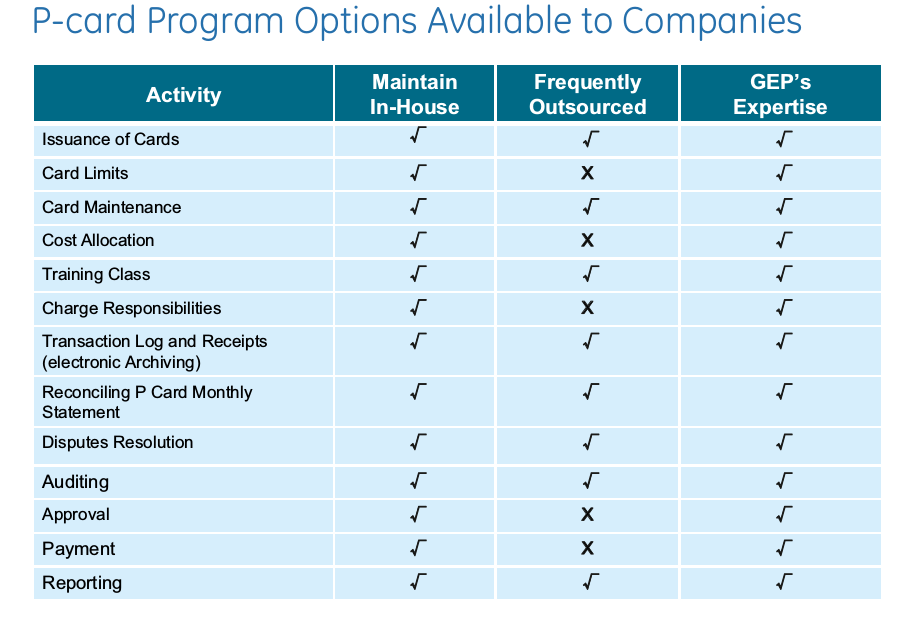
Theme: Procurement



